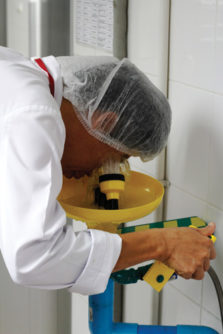Are your eyewash stations contaminated?

In the event of an emergency, having a properly working eyewash station is crucial. And keeping your eyewash station clean and free of contaminants is part of that.
“Water found in improperly maintained eyewash stations is more likely to contain organisms (e.g., acanthamoeba, pseudomonas, legionella) that thrive in stagnant or untreated water and are known to cause infections,” OSHA states, adding that these organisms can come in contact with a worker’s eyes or skin or be inhaled in the process of using an eyewash station. Workers who use contaminated eyewash stations may experience eye pain and redness, blurry vision, and eye inflammation for several days after using the station, according to OSHA.
Problems can arise if your workplace’s eyewash stations contain stagnant water or are otherwise improperly maintained. OSHA provides three examples of organisms that thrive in these conditions:
- Acanthamoeba can cause eye infections, including – in rare cases – acanthamoeba keratitis, which can lead to neurological or whole-body infections.
- Pseudomonas aeruginosa can cause eye, skin, muscle and lung infections. A telltale sign of this infection is green-blue pus around the infected area. If this infection spreads through the bloodstream, “workers may become very sick with fevers, chills, confusion, shock, and even death.” Additionally, infections from pseudomonas aeruginosa can be difficult to treat because it has developed resistance to a number of antibiotics.
- Legionella is a group of bacteria that lives in nature with amoeba that can cause severe lung infections. Because acanthamoeba are effective hosts for legionella, they may both be in contaminated eyewash water. “Although legionella does not cause eye infections, inhaling water droplets containing the bacteria can cause Legionnaires’ disease, a severe and fatal form of pneumonia,” OSHA states.
To help prevent infections, follow the eyewash manufacturer’s instructions, which include how and when to flush the systems and what solutions to use.
Post a comment to this article
Safety+Health welcomes comments that promote respectful dialogue. Please stay on topic. Comments that contain personal attacks, profanity or abusive language – or those aggressively promoting products or services – will be removed. We reserve the right to determine which comments violate our comment policy. (Anonymous comments are welcome; merely skip the “name” field in the comment box. An email address is required but will not be included with your comment.)

